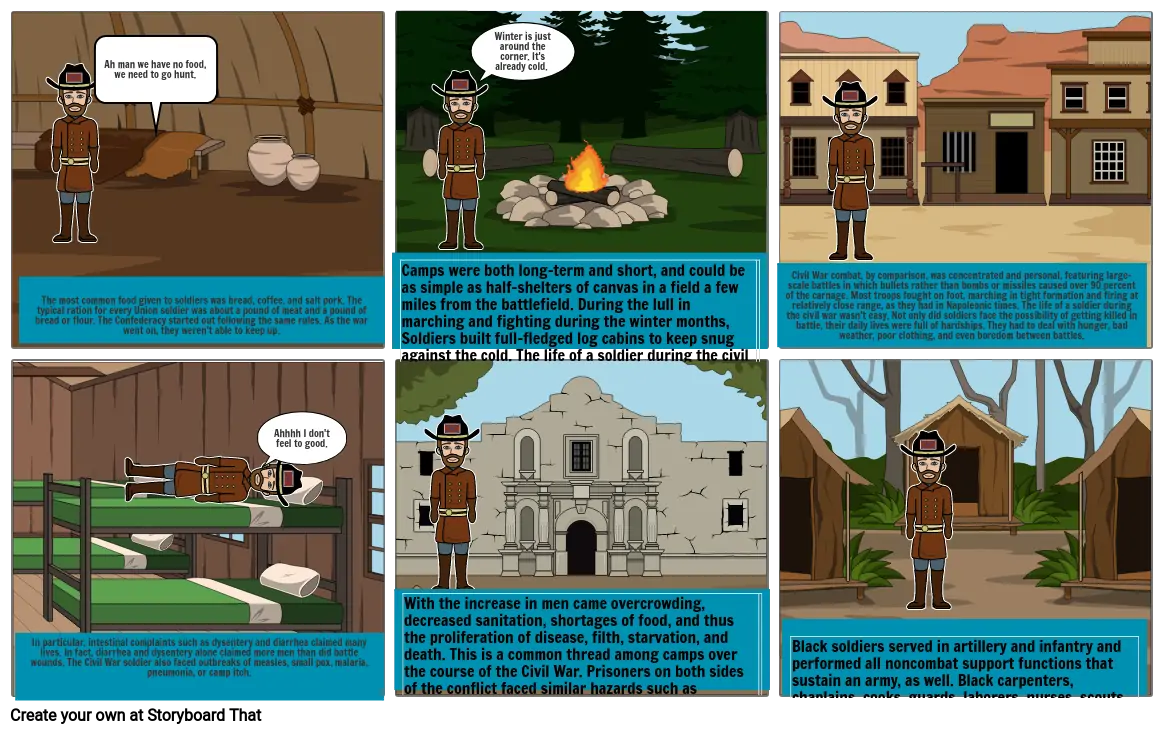Civil War Panels

Storyboard Description
These are panels that explain the hardships and what people had to go through in the Civil War.
Storyboard Text
- The most common food given to soldiers was bread, coffee, and salt pork. The typical ration for every Union soldier was about a pound of meat and a pound of bread or flour. The Confederacy started out following the same rules. As the war went on, they weren't able to keep up.
- Ah man we have no food, we need to go hunt.
- Camps were both long-term and short, and could be as simple as half-shelters of canvas in a field a few miles from the battlefield. During the lull in marching and fighting during the winter months, Soldiers built full-fledged log cabins to keep snug against the cold. The life of a soldier during the civil war wasn't easy. Not only did soldiers face the possibility of getting killed in battle, their daily lives were full of hardships. They had to deal with hunger, bad weather, poor clothing, and even boredom between battles. Soldiers were woken at dawn to begin their day.
- Winter is just around the corner. It's already cold.
- Civil War combat, by comparison, was concentrated and personal, featuring large-scale battles in which bullets rather than bombs or missiles caused over 90 percent of the carnage. Most troops fought on foot, marching in tight formation and firing at relatively close range, as they had in Napoleonic times. The life of a soldier during the civil war wasn't easy. Not only did soldiers face the possibility of getting killed in battle, their daily lives were full of hardships. They had to deal with hunger, bad weather, poor clothing, and even boredom between battles.
- In particular, intestinal complaints such as dysentery and diarrhea claimed many lives. In fact, diarrhea and dysentery alone claimed more men than did battle wounds. The Civil War soldier also faced outbreaks of measles, small pox, malaria, pneumonia, or camp itch.
- Ahhhh I don't feel to good.
- With the increase in men came overcrowding, decreased sanitation, shortages of food, and thus the proliferation of disease, filth, starvation, and death. This is a common thread among camps over the course of the Civil War. Prisoners on both sides of the conflict faced similar hazards such as contaminated drinking water, overcrowding, and diseases that passed between prisoners and prison camps. Diarrhea, dysentery, gangrene, scurvy and smallpox were all conditions that plagued prisoners.
- Black soldiers served in artillery and infantry and performed all noncombat support functions that sustain an army, as well. Black carpenters, chaplains, cooks, guards, laborers, nurses, scouts, spies, steamboat pilots, surgeons, and teamsters also contributed to the war cause. If they fought they would become a free man. That is why most African Americans joined the military.
Over 30 Million Storyboards Created

